大气降水是清除大气污染物的一种重要手段[1], 也是为陆地和水生生态系统提供必需营养物的一种途径.在清除过程中, 降水的化学组分、pH值和电导率等化学特征会发生改变, 所以研究化学特征能够间接了解大气污染状况.由于大气中各种污染物超过负荷, 世界大部分地区的雨水已被污染[2].这种污染会导致土壤和水的酸化、森林衰退和水体富营养化等一系列生态问题[3~5].
国际上对大气降水化学组分研究开始于20世纪40年代, 而我国开始于20世纪70年代末[6].目前, 国内学者对京津冀[7]、华东[8]、长三角[9]和珠三角[10]地区的大气降水化学组分及其来源已经有了较多的研究, 然而对西北地区的研究偏少.西安是我国西北地区最大的城市, 由于特殊的地理位置、工业的快速发展以及城市的扩张, 使西安成为我国大气污染较严重的城市之一.Shen等[11]发现2009年西安降水中SO42-和NO3-为主要酸性污染物, NH4+和Ca2+为主要碱性阳离子;Lu等[12]分析出2010年春季西安降水中主要离子SO42-、Ca2+、NH4+和NO3-占总离子的88%;Wang等[13]指出了西安2015年人为排放是降雨中SO42-、NH4+和NO3-最大的贡献源, 占比分别为61.9%、65.3%和70.5%.但以上对大气降水的研究时间均较短且较早, 难以全面反映西安大气污染变化规律以及污染现状.本研究分析了2000~2017年西安市大气降水化学特征以及沉降特征, 并通过正交矩阵分析法(PMF)解析了大气降水中SO42-、NO3-和NH4+的主要来源, 以期为有效应对西安大气污染提供科学依据.
1 材料与方法 1.1 数据来源及质量保证本研究观测地点位于西安市环境监测站(“市站”, 34°14′33″N, 108°57′10″E), 其海拔419 m, 周围主要为住宅区、商业区和交通路线.从2000年1月到2017年12月市站的月降水量、电导率、pH和离子记录数据来源于东亚酸沉降监测网络(EANET).该网站作为一项政府间倡议于1998年开始运行, 旨在就东亚酸沉降问题的状况达成共识, 为各级决策提供有效依据, 以预防和减少对环境的不利影响.
酸沉降监测周期为24 h, 从上午09:00至次日上午09:00.样品采集后现场测定样品的电导率和pH, 将剩余的样品收集在专用的酸雨取样瓶中, 放于4℃的冰箱中储存.在用离子色谱分析降雨离子组成时, 校准每次至少绘制5个浓度点的曲线, 每次实验测量空白样品, 并选择实际样品量的5%进行平行双份测量, 以确保数据准确性.测量、取样、化学分析、数据完整性、质量控制和质量保证等详细内容请参考东亚酸沉降监测网络网站(https://monitoring.eanet.asia/document/public/index).
1.2 Mann-Kendall趋势检验法Mann-Kendall趋势检验法是一种用于气象水文领域趋势判断的非参数统计检验方法[14].设具有n个样本量的时间序列x, 时间顺序为x1, x2, …, xn, 将其构造为一秩序列:

|
(1) |
假定原序列随机独立, 统计量dk的均值和方差如下:

|
(2) |

|
(3) |
式中, E(dk)为dk的均值, var(dk)为dk的方差, 将dk标准化得统计量UFk, 其定义为:

|
(4) |
按时间序列逆序xn, xn-1, …, x1, 再重复上述过程, 同时使

|
(5) |
用UFk和UBk分别组成UF和UB曲线.设定显著性水平α=0.05, 则统计量UF和UB的临界值均为±1.96.当统计量UF大于0, 表明序列呈上升趋势.反之, 序列呈下降趋势.当其超过临界值±1.96时, 表明上升或下降趋势显著.若UF与UB两条曲线相交于一点, 则该点所对应的时间为突变开始时间.
1.3 PMF受体模型作为受体模型, PMF现已广泛用于大气环境颗粒物的源解析[15].基于正定矩阵因子模型(PMF), 美国环境保护署(EPA)开发了PMF 5.0软件[16].它将给定的数据集分解为两个矩阵, 即源成分谱矩阵(F)和源贡献矩阵(G).PMF表达式如下[17]:

|
(6) |
式中, X为受体点位各组分浓度矩阵, E为残差矩阵.PMF运行之前需提供两组数据, 分别为浓度数据和不确定值数据.不确定值计算如下[18]:

|
(7) |
式中, UNC为各离子的不确定值, mg·L-1;MLD为各离子的检测限, mg·L-1;X为各离子的质量浓度, mg·L-1.实验所使用的离子分析仪器为美国戴安公司的Dionex ics-5000, Na+、NH4+、K+、Mg2+、Ca2+、Cl-、NO3-和SO42-的检测限分别为0.05、0.05、0.05、0.05、0.05、0.01、0.05和0.05 mg·L-1.
2 结果与讨论 2.1 大气降水化学特征 2.1.1 大气降水pH和电导率特征2000~2017年西安市大气降水pH及电导率年际变化如图 1所示, 可以看出, 西安市大气降水pH在5.0~7.0之间变化, 其中2005~2007年大气降水pH均小于5.6, 分别为5.41、5.56和5.52.自2007年以后, 大气降水pH值呈明显上升趋势, 说明西安市大气降水酸化问题得到改善. 2000~2017年西安市大气降水的电导率变化在3.69~19.5 mS·m-1之间, 其中最高电导率出现在2001年.自2003年以来, 西安市的降水电导率整体呈下降趋势, 并在2017年达到最低值, 表明西安市大气降水的污染情况明显好转.值得注意的是, 尽管2000~2002年期间降水没有出现酸化(pH>5.6), 但该期间出现的高电导率值说明了降水污染较为严重.
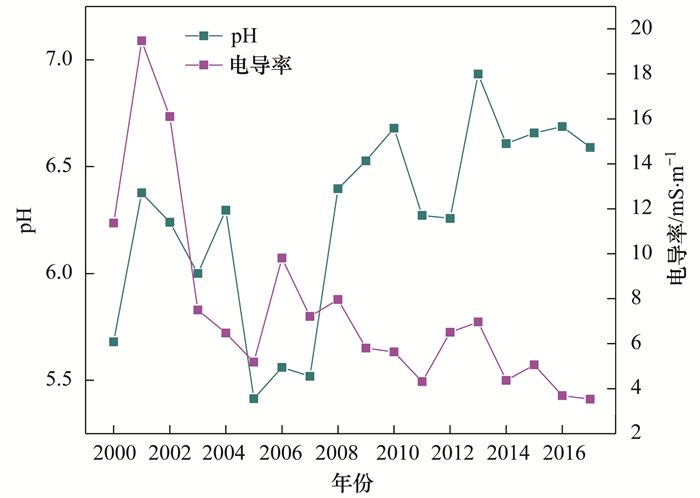
|
图 1 西安市2000~2017年大气降水pH和电导率变化 Fig. 1 Changes of pH and conductivity in precipitation in Xi'an City from 2000 to 2017 |
表 1为西安市大气降水中主要离子化学组成.可以发现, 2000~2017年西安市降水离子浓度由高到低顺序为:SO42->Ca2+>NH4+>NO3->Na+>Cl->Mg2+>K+.其中降水中最主要的水溶性离子是SO42-和Ca2+, 平均浓度分别高达416.8 μeq·L-1和392.8 μeq·L-1, 分别占总离子浓度的33.5%和31.5%.大气降水阴离子中NO3-浓度仅次于SO42-, 占总离子浓度的5.3%, 表明硝酸盐和硫酸盐是该地区主要的酸性物质.NH4+在阳离子中位居第二, 占阳离子总量的24.8%;NH4+和Ca2+成为中和酸性物质的主要离子. Cl-、Na+、K+和Mg2+平均浓度分别为51.7、63.7、31.0和47.0 μeq·L-1, 分别占总离子浓度的4.2%、5.1%、2.5%和3.8%.通常SO42-/NO3-大于3, 认为污染物排放类型为燃煤型;介于0.5和3之间, 认为污染物排放类型为混合型;小于0.5时, 认为污染物排放类型为燃油型[19].西安SO42-/NO3-在2000~2017年期间变化较大, 最近几年该比值总体均介于0.5和3之间, 表明西安市大气污染物排放类型由燃煤型向混合型转变的趋势.([Ca2+]+[NH4+])/([SO42-]+[NO3-])大于1(除2002年和2007年), 表明西安市降水酸度除了SO42-、NO3-外还受到碳酸以及有机酸的影响[20].
|
|
表 1 西安市大气降水中主要的水溶性离子/μeq·L-1 Table 1 Major water-soluble ions in precipitation in Xi' an City/μeq·L-1 |
西安市与其它地区大气降水中的水溶性离子浓度相比(表 2), 总离子浓度与同位于我国北方的北京、天津、太原相似, 均处于较高水平;而与位于南方的贵阳、桂林和池州相比, 西安市降水总离子浓度是它们的1.3~1.8倍, 说明南方城市降水污染情况比西安市要好.这主要是与南、北方的气候、地理环境和能源结构不同所致.值得注意的是, 西安市降水中SO42-浓度高于池州, 与桂林相近, 但低于北京、天津、太原和贵阳;而Ca2+浓度北方城市要比南方高, 反映了风沙扬尘对降水中离子的极大影响.此外, 北方的北京、天津、太原和西安降水中NH4+要高于南方的贵阳、桂林和池州, 这主要与北方这4座城市NH3排放量高有关[21].
|
|
表 2 其它城市降水中各水溶性离子浓度/μeq·L-1 Table 2 Concentrations of water-soluble ions in precipitation in some cities/μeq·L-1 |
2.1.3 趋势分析
应用Mann-Kendall趋势检验评估2000~2017年西安市SO42-、NO3-、NH4+浓度变化趋势.图 2显示了连续216个月SO42-、NO3-、NH4+的UF和UB以及0.05的显著性水平线.从中可知, 西安市大气降水中SO42-和NO3-浓度变化相似, 2000~2017年基本上呈现下降趋势, 2002~2003年期间大部分月份呈现上升趋势, 在2001~2004年期间均出现4个突变点.西安市SO42-浓度下降主要是由于西安市1999年实施“煤改气工程”[28], 以及我国在“十一五”规划(2006~2010年)和“十二五”规划(2011~2015年)实施的二氧化硫减排[29].NO3-浓度下降是因为我国在“十二五”规划(2011~2015年)采取NOx控制措施[30]. NH4+浓度2000~2017年呈现下降趋势, Wang等[13]的研究发现2015年西安降水中NH4+浓度与2009年相比下降了2.9%.
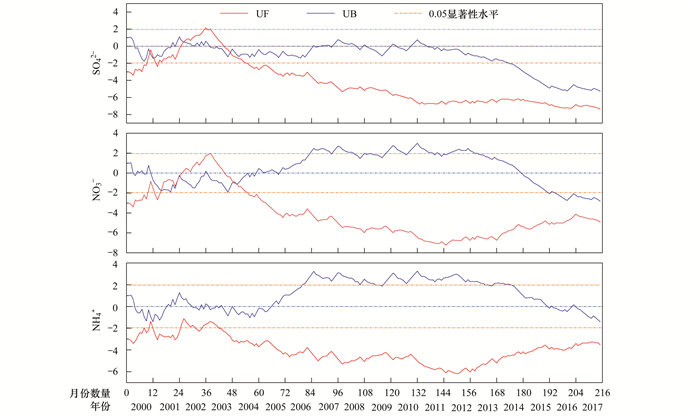
|
图 2 西安市SO42-、NO3-和NH4+的Mann-Kendall检验曲线 Fig. 2 Mann-Kendall test curves of SO42-, NO3- and NH4+ in Xi'an City from 2000 to 2017 |
图 3给出了西安市2000~2017年大气降水中SO42-、NO3-、NH4+和Ca2+沉降量的年际变化.可以看出, 大气降水中SO42-年均沉降量高于其它3种离子, 并于2002年达到最高[284.69 kg·(hm2·a)-1]. 2002年以后, SO42-的沉降量整体呈下降趋势, 与Mann-Kendall检验所得结果相一致. 2016年的SO42-沉降量降到最低, 其值仅为2002年的8.7%. 2000~2017年西安市降水中NO3-、NH4+和Ca2+沉降量分别在3.82~53.71、7.70~42.35和5.80~131.62 kg·(hm2·a)-1之间变化, 并且它们的变化趋势总体基本一致.降水中Cl-、K+、Na+和Mg2+与上述4种离子相比, 沉降量较小, 基本上均在10 kg·(hm2·a)-1以内变化.

|
图 3 大气降水中SO42-、NO3-、NH4+和Ca2+沉降量年际变化 Fig. 3 Interannual variations of SO42-, NO3-, NH4+, and Ca2+ deposition in atmospheric precipitation |
硫和氮主要以SO42-、NO3-和NH4+的形式沉降到地表, 导致自然植被的破坏和土壤酸化等环境问题[31].图 4为西安市降水中氮和硫沉降量的年际变化.可以看出, 2000~2013年西安市降水中硫的沉降量高于氮的沉降量, 尤其在2000~2006年硫沉降量是氮沉降量的3.21倍;但2014年以后, 这种变化趋势发生了改变, 含氮化合物的沉降量略高于含硫的沉降量, 这主要与二氧化硫的减排有关. 2000~2017年西安市大气降水中含氮物质的沉降量在6.36~39.75 kg·(hm2·a)-1之间变化, 含氮化合物的平均沉降量为16.89 kg·(hm2·a)-1, 高于我国的平均值9.88 kg·(hm2·a)-1[32], 表明西安市降水中氮污染较严重.
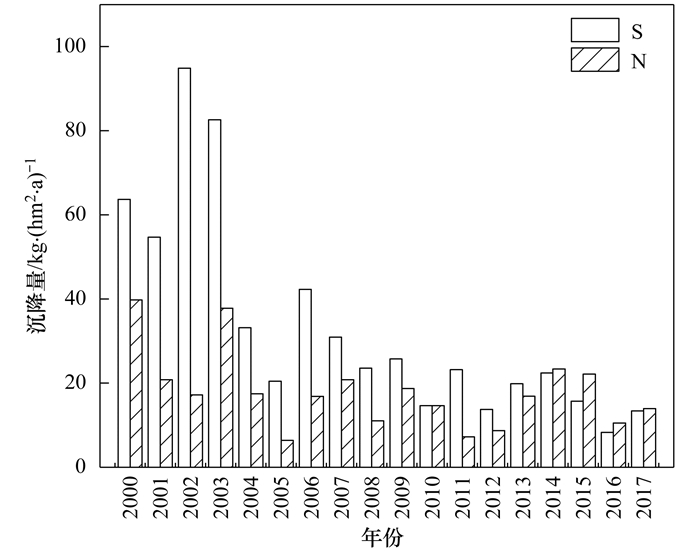
|
图 4 西安市大气降水氮和硫沉降量的年际变化 Fig. 4 Interannual variation of nitrogen and sulfur deposition in atmospheric precipitation in Xi'an City |
NH4+的来源包括从肥料、人类和动物粪便中挥发出的NH3发生反应所生成, 大气中的NH4+主要与农业活动密切相关;而NO3-的来源主要是从发电厂、汽车和生物质燃烧的化石燃料燃烧中排放的NOx, 与工业活动密切相关.因此, 湿沉降中的NH4+-N/NO3--N在很大程度上反映了大气中活性氮的主要来源, 当NH4+-N/NO3--N大于1时, 说明活性氮主要来源于农业活动, 若比值小于1, 则活性氮主要来源于工业活动[33].图 5给出了西安市NH4+-N、NO3--N的沉降量以及NH4+-N/NO3--N的年际变化.很显然, NH4+-N为西安市活性氮的主要沉降成分.NH4+-N和NO3--N的平均沉降量分别为13.14 kg·(hm2·a)-1和4.86 kg·(hm2·a)-1.值得注意的是, 二者的平均比值为3.31, 高于我国的平均水平(1.22)[34], 表明农业活动为西安市大气活性氮的主要来源.
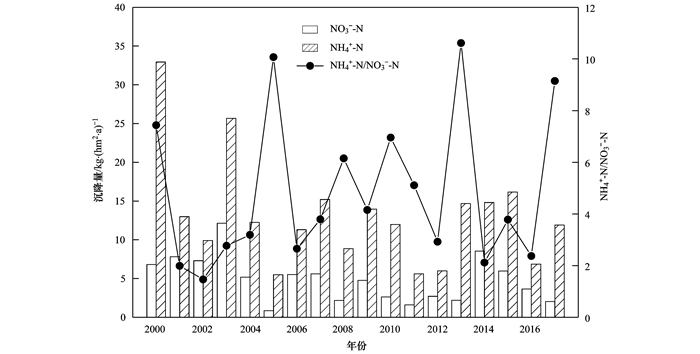
|
图 5 西安市大气降水NH4+-N和NO3--N的沉降量以及NH4+-N/NO3--N的年际变化 Fig. 5 Annual variation of NH4+-N and NO3--N, and NH4+-N/NO3--N in atmospheric precipitation in Xi'an City |
为了确定大气降水中离子之间的联系, 计算了降水中离子组分之间的相关系数(表 3).其中SO42-和NH4+、NO3-和NH4+相关系数均不高(均低于0. 5), 而国内大部分研究SO42-和NH4+、NO3-和NH4+相关系数均较高, 如许肖云等[35]计算出SO42-和NH4+、NO3-和NH4+之间相关系数分别为0.752和0.598, 表明西安市大气降水中SO42-和NH4+以及NO3-和NH4+主要来源都不同.SO42-和NO3-相关性较好, 相关系数为0.78, 这是由于它们的前体物(SO2和NOx)的来源相同(化石燃料燃烧)以及它们在雨水和空气传播颗粒中的化学行为的相似性[36].Ca2+和Mg2+相关系数达到0.80, 说明Ca2+和Mg2+有共同的来源, 这个来源可能为扬尘源或土壤源[37]. Na+与SO42-、NO3-、Cl-相关系数都较高, 说明雨水中的Na+可能以Na2SO4、NaNO3和NaCl等形式存在[38].
|
|
表 3 西安市大气降水中水溶性离子相关系数1) Table 3 Correlation coefficients of water-soluble ions in atmospheric precipitation in Xi'an City |
2.3.2 PMF受体模型源解析
通过8种离子的浓度数据的源解析, 最终得出这8种水溶性离子存在5个来源, 图 6为湿沉降样品中SO42-、NO3-和NH4+这3种离子预测值与观测值的比较, 3种离子的预测值与观测值高度匹配, 表明PMF运行结果较好.从解析结果(图 7)可知, 因子1中Cl-载荷最大, 其次是Na+, 分别贡献了总量的97.17%和55.89%, Cl-和Na+都为海盐的组成离子, 故因子1可认为是海盐.海盐主要来自于海洋, 而西安处于中国内陆, 西安所出现的海盐可能受东北风的长途输送的影响.因子2中Ca2+载荷最大, 其次是Mg2+、K+和Na+, 分别贡献了总量的74.02%、61.09%、47.50%和41.94%, Ca2+、Na+、K+和Mg2+为扬尘的示踪元素[39], 故因子2可代表扬尘.因子3中NH4+载荷最大, 贡献了总量的75.47%, NH4+与农田里所施用硫酸铵、硝酸铵等氮肥有关[40], 故因子3代表农业源.因子4中SO42-载荷最大, 贡献了总量的67.52%, SO42-主要来源于煤炭等化石燃料燃烧所释放的SO2转化而成[41], 故认为因子4可能为化石燃料燃烧.因子5中NO3-载荷较为突出, 贡献了总量的72.99%, NOx与机动车排放有关, 而NO3-主要来自于NOx二次转化[42], 故可认为因子5为机动车排放.
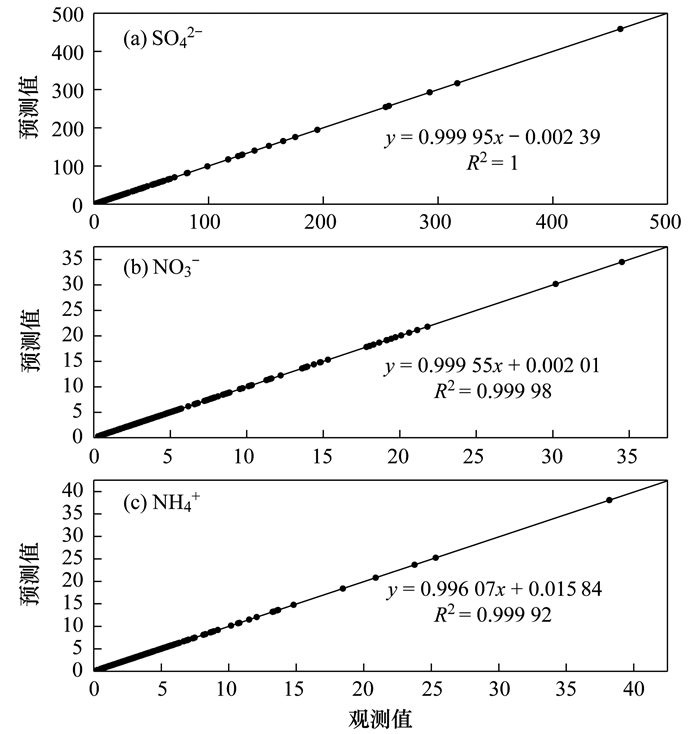
|
图 6 湿沉降样品中PMF预测值与观测值的比较 Fig. 6 Comparison of predicted PMF and observed values in wet deposition samples |

|
图 7 大气降水中水溶性无机离子PMF源解析结果 Fig. 7 Analytical results of PMF source of water-soluble inorganic ions in atmospheric precipitation |
PMF解析的8种水溶性离子存在5个来源, 各源对主要水溶性离子SO42-、NO3-和NH4+的贡献率如图 8所示.SO42-来源于扬尘(5.24%)、农业(11.81%)、化石燃料燃烧(67.52%)和机动车排放(15.43%). NO3-来源于海盐(0.98%)、扬尘(1.41%)、农业(24.61%)和机动车排放(72.99%). NH4+来源于扬尘(14.89%)、农业(75.47%)和化石燃料燃烧(9.64%).
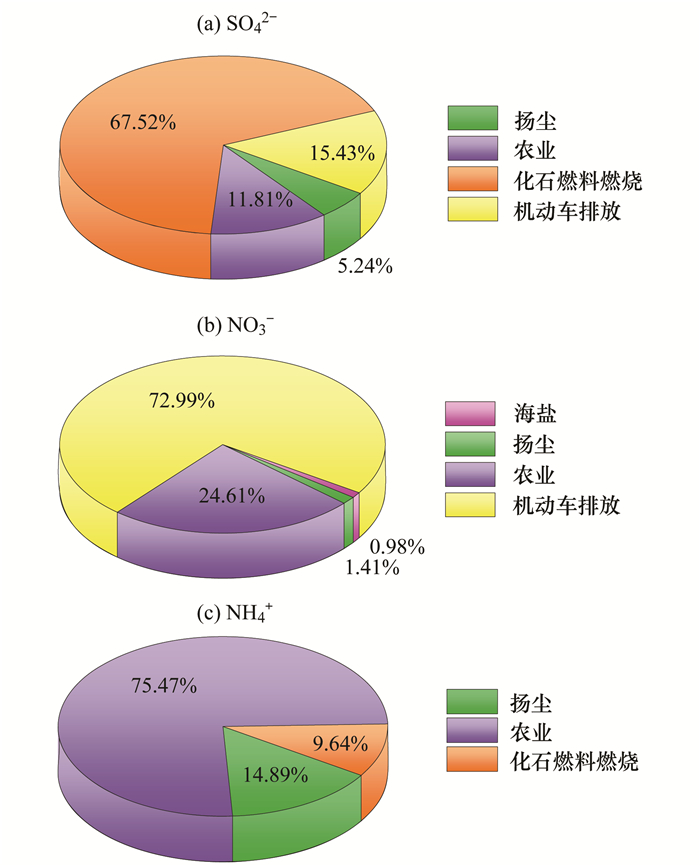
|
图 8 各源对西安市大气降水中SO42-、NO3-和NH4+的贡献率 Fig. 8 Contribution rate of sources to SO42-, NO3-, and NH4+ in atmospheric precipitation in Xi'an City |
(1) 2000~2017年西安市降水pH整体处于上升趋势, 仅在2005~2007年大气降水出现酸化;降水电导率整体呈下降趋势, 表明西安市大气降水的污染情况明显好转.
(2) 西安市水溶性离子中以SO42-、NO3-、NH4+和Ca2+为主, 平均浓度分别为416.8、66.0、176.5和392.8 μeq·L-1;2000~2017年西安市大气降水中SO42-、NO3-和NH4+浓度整体呈下降趋势.
(3) 西安市大气降水中氮和硫的沉降量分别为16.89 kg·(hm2·a)-1和33.52 kg·(hm2·a)-1, 2000~2013年硫的沉降量高于氮的沉降量, 而2014~2017年的结果则相反;NH4+-N和NO3-N的平均比值为3.31, 高于我国的平均水平.
(4) 化石燃料燃烧、机动车排放和农业分别是西安大气降水中SO42-、NO3-和NH4+的主要贡献者, 占比分别为67.52%、72.99%和75.47%.
致谢: 感谢东亚酸沉降监测网为本文提供数据和资料.
| [1] | Migliavacca D, Teixeira E C, Wiegand F, et al. Atmospheric precipitation and chemical composition of an urban site, Guaíba hydrographic basin, Brazil[J]. Atmospheric Environment, 2005, 39(10): 1829-1844. DOI:10.1016/j.atmosenv.2004.12.005 |
| [2] | Meng Y, Zhao Y L, Li R, et al. Characterization of inorganic ions in rainwater in the megacity of Shanghai:spatiotemporal variations and source apportionment[J]. Atmospheric Research, 2019, 222: 12-24. DOI:10.1016/j.atmosres.2019.01.023 |
| [3] |
段雷, 周益, 杨永森, 等. 酸化及化学修复剂对森林土壤有机物淋溶的影响[J]. 环境科学, 2008, 29(2): 440-445. Duan L, Zhou Y, Yang Y S, et al. Effects of acidification and liming on organic matter leaching in forest soil[J]. Environmental Science, 2008, 29(2): 440-445. DOI:10.3321/j.issn:0250-3301.2008.02.028 |
| [4] |
唐先干, 杨金玲, 张甘霖. 皖南山区降水酸性特征与元素沉降通量[J]. 环境科学, 2009, 30(2): 356-361. Tang X G, Yang J L, Zhang G L. Acidity characteristics and element flux of rainwater in the hilly area of South Anhui, China[J]. Environmental Science, 2009, 30(2): 356-361. DOI:10.3321/j.issn:0250-3301.2009.02.007 |
| [5] | Camargo J A, Alonso Á. Ecological and toxicological effects of inorganic nitrogen pollution in aquatic ecosystems:a global assessment[J]. Environment International, 2006, 32(6): 831-849. DOI:10.1016/j.envint.2006.05.002 |
| [6] |
汪少勇, 何晓波, 吴锦奎, 等. 长江源区大气降水化学特征及离子来源[J]. 环境科学, 2019, 40(10): 4431-4439. Wang S Y, He X B, Wu J K, et al. Chemical characteristics and ionic sources of precipitation in the source region of the Yangtze River[J]. Environmental Science, 2019, 40(10): 4431-4439. |
| [7] | 孙倩, 霍铭群, 刘兆荣, 等.北京大气降水化学特征研究[A].见: 第12届全国离子色谱学术报告会论文集[C].厦门: 中国仪器仪表学会, 2008. 74-78. http://cpfd.cnki.com.cn/Article/CPFDTOTAL-XMDZ200811001023.htm |
| [8] | Niu Y W, Li X L, Huang Z, et al. Chemical characteristics and possible causes of acid rain at a regional atmospheric background site in Eastern China[J]. Air Quality, Atmosphere & Health, 2017, 10(8): 971-980. |
| [9] |
刘贵荣, 汪伟峰, 周军, 等. 宁波市"十二五"与"十一五"期间酸雨污染特征变化趋势分析[J]. 中国环境监测, 2018, 34(3): 39-44. Liu G R, Wang W F, Zhou J, et al. Analysis on the trend of acid rain characteristics during "Eleventh Five-Year" and "Twelfth Five-Year" period in Ningbo[J]. Environmental Monitoring in China, 2018, 34(3): 39-44. |
| [10] | Zhou X D, Xu Z F, Liu W J, et al. Chemical composition of precipitation in Shenzhen, a coastal mega-city in South China:influence of urbanization and anthropogenic activities on acidity and ionic composition[J]. Science of the Total Environment, 2019, 662: 218-226. DOI:10.1016/j.scitotenv.2019.01.096 |
| [11] | Shen Z X, Zhang L M, Cao J J, et al. Chemical composition, sources, and deposition fluxes of water-soluble inorganic ions obtained from precipitation chemistry measurements collected at an urban site in Northwest China[J]. Journal of Environmental Monitoring, 2012, 14(11): 3000-3008. DOI:10.1039/c2em30457k |
| [12] | Lu X W, Li L Y, Li N, et al. Chemical characteristics of spring rainwater of Xi'an City, NW China[J]. Atmospheric Environment, 2011, 45(28): 5058-5063. DOI:10.1016/j.atmosenv.2011.06.026 |
| [13] | Wang L Q, Shen Z X, Lu D, et al. Water-soluble components in rainwater over Xi'an in northwest China:source apportionment and pollution controls effectiveness evaluation[J]. Atmospheric Pollution Research, 2018, 10(2): 395-403. |
| [14] | Yadav S, Deb P, Kumar S, et al. Trends in major and minor meteorological variables and their influence on reference evapotranspiration for mid Himalayan region at east Sikkim, India[J]. Journal of Mountain Science, 2016, 13(2): 302-315. DOI:10.1007/s11629-014-3238-3 |
| [15] | Li L, Lai W, Pu J G, et al. Polar organic tracers in PM2.5 aerosols from an inland background area in Southwest China:correlations between secondary organic aerosol tracers and source apportionment[J]. Journal of Environmental Sciences, 2018, 69: 281-293. DOI:10.1016/j.jes.2017.06.002 |
| [16] |
康宝荣, 刘立忠, 刘焕武, 等. 关中地区细颗粒物碳组分特征及来源解析[J]. 环境科学, 2019, 40(8): 3431-3437. Kang B R, Liu L Z, Liu H W, et al. Pollution characteristics and sources of carbonaceous components in PM2.5 in the Guanzhong Area[J]. Environmental Science, 2019, 40(8): 3431-3437. |
| [17] |
王成龙, 邹欣庆, 赵一飞, 等. 基于PMF模型的长江流域水体中多环芳烃来源解析及生态风险评价[J]. 环境科学, 2016, 37(10): 3789-3797. Wang C L, Zou X Q, Zhao Y F, et al. Source apportionment and ecological risk assessment of polycyclic aromatic hydrocarbons in surface water from Yangtze River, China:based on PMF model[J]. Environmental Science, 2016, 37(10): 3789-3797. |
| [18] |
张玉欣, 安俊琳, 林旭, 等. 南京北郊冬季挥发性有机物来源解析及苯系物健康评估[J]. 环境科学, 2017, 38(1): 1-12. Zhang Y X, An J L, Lin X, et al. Source apportionment of volatile organic compounds and health assessment of benzene series in Northern Suburb of Nanjing in winter[J]. Environmental Science, 2017, 38(1): 1-12. |
| [19] |
马琳.上海市降水中水溶性离子组成特征及源解析研究[D].上海: 复旦大学, 2011. 31-32. Ma L. Characteristics and source apportionment of water-soluble ions in precipitation over Shanghai, China[D]. Shanghai: Fudan University, 2011. 31-32. http://www.wanfangdata.com.cn/details/detail.do?_type=degree&id=D396677 |
| [20] |
杨懂艳, 李秀金, 陈圆圆, 等. 北京市湿沉降特征分析[J]. 环境科学, 2011, 32(7): 1867-1873. Yang D Y, Li X J, Chen Y Y, et al. Characteristics of chemical compositions of precipitation in Beijing[J]. Environmental Science, 2011, 32(7): 1867-1873. |
| [21] |
张苗云, 王世杰, 张迎, 等. 金华市大气降水的化学组成特征及来源解析[J]. 中国环境监测, 2007, 23(6): 86-92. Zhang M Y, Wang S J, Zhang Y, et al. Analysis on the origin and characteristics of chemical composition of precipitation in Jinhua[J]. Environmental Monitoring in China, 2007, 23(6): 86-92. DOI:10.3969/j.issn.1002-6002.2007.06.025 |
| [22] | Yang F, Tan J, Shi Z B, et al. Five-year record of atmospheric precipitation chemistry in urban Beijing, China[J]. Atmospheric Chemistry and Physics, 2012, 12(4): 2025-2035. DOI:10.5194/acp-12-2025-2012 |
| [23] |
陈魁, 肖致美, 李鹏, 等. 天津市大气降水化学组分变化趋势及来源研究[J]. 环境科学学报, 2015, 35(4): 956-964. Chen K, Xiao Z M, Li P, et al. Trend and sources of chemical composition of atmospheric precipitation in Tianjin[J]. Acta Scientiae Circumstantiae, 2015, 35(4): 956-964. |
| [24] |
郭晓方, 崔阳, 王开扬, 等. 近3年太原市夏季降水的化学特征研究[J]. 环境科学, 2015, 36(2): 388-395. Guo X F, Cui Y, Wang K Y, et al. Chemical characteristics of 3-year atmospheric precipitation in summer, Taiyuan[J]. Environmental Science, 2015, 36(2): 388-395. |
| [25] |
肖红伟, 肖化云, 王燕丽. 贵阳大气降水化学特征及来源分析[J]. 中国环境科学, 2010, 30(12): 1590-1596. Xiao H W, Xiao H Y, Wang Y L. Chemical characteristics and source apportionment of precipitation in Guiyang[J]. China Environmental Science, 2010, 30(12): 1590-1596. |
| [26] | Yu S, Kuo Y M, Du W Y, et al. The hydrochemistry properties of precipitation in karst tourism city (Guilin), Southwest China[J]. Environmental Earth Sciences, 2015, 74(2): 1061-1069. DOI:10.1007/s12665-015-4235-8 |
| [27] | Xu Z F, Wu Y, Liu W J, et al. Chemical composition of rainwater and the acid neutralizing effect at Beijing and Chizhou city, China[J]. Atmospheric Research, 2015, 164-165: 278-285. DOI:10.1016/j.atmosres.2015.05.009 |
| [28] |
孙根年, 吴晓娟, 周立花. 西安大气SO2/NOx污染时空变化的分析[J]. 干旱区资源与环境, 2006, 20(5): 99-103. Sun G N, Wu X J, Zhou L H. Analysis on temporal and spatial changes of SO2/NOx in Xi'an City during 1991-2002[J]. Journal of Arid Land Resources and Environment, 2006, 20(5): 99-103. DOI:10.3969/j.issn.1003-7578.2006.05.020 |
| [29] | Luo X S, Pan Y P, Goulding K, et al. Spatial and seasonal variations of atmospheric sulfur concentrations and dry deposition at 16 rural and suburban sites in China[J]. Atmospheric Environment, 2016, 146: 79-89. DOI:10.1016/j.atmosenv.2016.07.038 |
| [30] | Zhao B, Wang S X, Wang J D, et al. Impact of national NOx and SO2 control policies on particulate matter pollution in China[J]. Atmospheric Environment, 2013, 77: 453-463. DOI:10.1016/j.atmosenv.2013.05.012 |
| [31] | Qiao X, Du J, Kota S H, et al. Wet deposition of sulfur and nitrogen in Jiuzhaigou National Nature Reserve, Sichuan, China during 2015-2016:possible effects from regional emission reduction and local tourist activities[J]. Environmental Pollution, 2018, 233: 267-277. DOI:10.1016/j.envpol.2017.08.041 |
| [32] | Lü C Q, Tian H Q. Spatial and temporal patterns of nitrogen deposition in China:synthesis of observational data[J]. Journal of Geophysical Research:Atmospheres, 2007, 112(D22): D22S05. DOI:10.1029/2006JD007990 |
| [33] | Zhu J X, He N P, Wang Q F, et al. The composition, spatial patterns, and influencing factors of atmospheric wet nitrogen deposition in Chinese terrestrial ecosystems[J]. Science of the Total Environment, 2015, 511: 777-785. DOI:10.1016/j.scitotenv.2014.12.038 |
| [34] | Liu L, Zhang X Y, Lu X H. The composition, seasonal variation, and potential sources of the atmospheric wet sulfur (S) and nitrogen (N) deposition in the southwest of China[J]. Environmental Science and Pollution Research, 2016, 23(7): 6363-6375. DOI:10.1007/s11356-015-5844-1 |
| [35] |
许肖云, 张乘燕, 杨永安, 等. 近10年来遂宁市大气降水化学组分特征及来源分析[J]. 环境科学与技术, 2017, 40(S1): 163-169. Xu X Y, Zhang C Y, Yang Y A, et al. Analysis on characteristic and source of chemical composition of precipitation in Suining for the past ten years[J]. Environmental Science & Technology, 2017, 40(S1): 163-169. |
| [36] | Al-Khashman O A. Ionic composition of wet precipitation in the Petra Region, Jordan[J]. Atmospheric Research, 2005, 78(1-2): 1-12. DOI:10.1016/j.atmosres.2005.02.003 |
| [37] |
薛国强, 朱彬, 王红磊. 南京市大气颗粒物中水溶性离子的粒径分布和来源解析[J]. 环境科学, 2014, 35(5): 1633-1643. Xue G Q, Zhu B, Wang H L. Size distributions and source apportionment of soluble ions in aerosol in Nanjing[J]. Environmental Science, 2014, 35(5): 1633-1643. |
| [38] |
肖红伟, 肖化云, 张忠义, 等. 西沙永兴岛大气降水化学特征及来源分析[J]. 中国环境科学, 2016, 36(11): 3237-3244. Xiao H W, Xiao H Y, Zhang Z Y, et al. Chemical characteristics and source apportionment of atmospheric precipitation in Yongxing Island[J]. China Environmental Science, 2016, 36(11): 3237-3244. DOI:10.3969/j.issn.1000-6923.2016.11.005 |
| [39] | Sharma S K, Mandal T K, Jain S, et al. Source Apportionment of PM2.5 in Delhi, India Using PMF Model[J]. Bulletin of Environmental Contamination and Toxicology, 2016, 97(2): 286-293. DOI:10.1007/s00128-016-1836-1 |
| [40] |
徐敬, 张小玲, 徐晓斌, 等. 上甸子本底站湿沉降化学成分变化与来源解析[J]. 环境科学学报, 2008, 28(5): 1001-1006. Xu J, Zhang X L, Xu X B, et al. Variations and source identification of chemical compositions in wet deposition at Shangdianzi background station[J]. Acta Scientiae Circumstantiae, 2008, 28(5): 1001-1006. DOI:10.3321/j.issn:0253-2468.2008.05.031 |
| [41] |
张伟, 姬亚芹, 张军, 等. 辽宁省典型城市道路尘PM2.5成分谱研究[J]. 中国环境科学, 2018, 38(2): 412-417. Zhang W, Ji Y Q, Zhang J, et al. Study on the road dust source profile of PM2.5 in Liaoning Province typical cities[J]. China Environmental Science, 2018, 38(2): 412-417. DOI:10.3969/j.issn.1000-6923.2018.02.002 |
| [42] |
施双双, 王红磊, 朱彬, 等. 冬季临安大气本底站气溶胶来源解析及其粒径分布特征[J]. 环境科学, 2017, 38(10): 4024-4033. Shi S S, Wang H L, Zhu B, et al. Source apportionment and size distribution of aerosols at Lin'an atmosphere regional background Station during winter[J]. Environmental Science, 2017, 38(10): 4024-4033. |
 2020, Vol. 41
2020, Vol. 41


